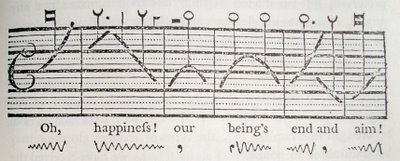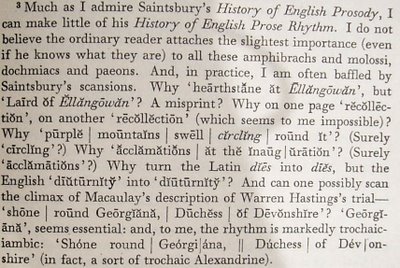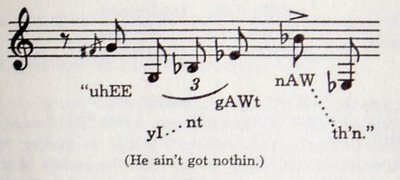On the notation of speech
Joshua Steele, Prosodia Rationalis (1779, Olms reprint 1971).
Rousseau was pretty influential when he claimed a musical origin for human speech in his essay on the topic, composed in the early 1760s. It is the ultimate Romantic fantasy, that man's logos was first forged in the fire of a heroic song of the passions.
Steele's Prosodia Rationalis was an oddity, turning the period English interest in prosody—metrical scansion, associated with textual criticism and the great dramatic tradition—towards the notation of music, towards the notion of speech as song. Steele discovered the sonic complexity of spoken language; where his opponent, Lord Monboddo (addressed not by name, but only as the author of The Origin and Progress of Language) sees only 'motion', Steele distinguishes sound (acute or grave), cadence (arsis or thesis, light or heavy), quantity (long or short), and quality (loud or soft) in each syllable. One of the subtlest aspects of Steele's book is his observation that speech does not exactly follow the 'chromatico-diatonic' scale of sung syllables, which land on distinct tones between grave (low) and acute (high). As he puts it, 'the melody of speech moves rapidly up or down by slides, wherein no graduated distinction of tones or semitones can be measured by the ear: nor does the voice (in our language) ever dwell distinctly, for any perceptible space of time, on any certain level or uniform tone, except the last tone on which the speaker ends or makes a pause.' An explanation of Steele's experimental method, for which he used a bass viol, can be found in Hunter Hatfield's introductory article on the text, written from the perspective of modern phonology.
As well as articulating the various phonic elements in a spoken syllable, Steele aims to transcribe these elements by analogy with musical staves: as Jed Rasula and Steve McCaffrey put it (Imagining Language, 1998—highly recommended for all lovers of unusual linguistics), 'a detailed visual system of notation designed to facilitate a poem’s accurate, aural realization in musical form'. Here we see an expanded representation of a line from Pope's Essay on Man:

The curved lines represent the accent or sliding pitch of the voice articulating each syllable, while the tails are variants on the standard symbols for semi-breve, minim and crotchet, denoting quantity. The tittles and bars by the tails stand for pauses and elongations of the note. The jagged lines at the bottom, finally, denote variations in quality, crescendi e smorzandi through the line. The one factor omitted from this diagram is cadence, and in fact Steele uses cadence instead of quality throughout the rest of the book, as more accurate, and more useful to denote emphasis in prose and verse. Here are two versions of what was already the most famous speech in the language:


Here the triangle denotes a stressed syllable (or pause in lieu of one), three dots a light or unstressed syllable, and two dots 'the lightest' syllable. The reader will also notice that Steele has simplified his elaborate arcs in favour of short strokes for accent. The second version here was inspired by watching a performance by David Garrick, who 'delivered [the soliloquy] with little or no distinction of piano and forte, but nearly uniform; something below the ordinary force, or, as a musician would say, sotto voce, or sempre poco piano'. One can easily reconstruct the sound of the voice from this notation, fitting together each aspect of the vocal timbre into a whole—and this was just Steele's intention, that 'the types of modern elocution may be transmitted to posterity as accurately as we have received the musical compositions of Corelli'. Several other passages are notated likewise, including the opening of Paradise Lost, and extracts from the Iliad and Butler's Hudibras.
George: You want me to roar?
Mossop: Well, of course we wish you to roar. All the great orators roar before commencing with their speeches. It is the way of things. Ah, Mr. Keanrick, from your Hamlet, please.
Keanrick: Hh-hm. (orates) OOOOoooohhhhh. . . To be or not to be.
Mossop: From your Julius Caesar.
Keanrick: OoooHHHHOOOOHHH. . . Friends, Romans, countrymen.
Rousseau was pretty influential when he claimed a musical origin for human speech in his essay on the topic, composed in the early 1760s. It is the ultimate Romantic fantasy, that man's logos was first forged in the fire of a heroic song of the passions.
Steele's Prosodia Rationalis was an oddity, turning the period English interest in prosody—metrical scansion, associated with textual criticism and the great dramatic tradition—towards the notation of music, towards the notion of speech as song. Steele discovered the sonic complexity of spoken language; where his opponent, Lord Monboddo (addressed not by name, but only as the author of The Origin and Progress of Language) sees only 'motion', Steele distinguishes sound (acute or grave), cadence (arsis or thesis, light or heavy), quantity (long or short), and quality (loud or soft) in each syllable. One of the subtlest aspects of Steele's book is his observation that speech does not exactly follow the 'chromatico-diatonic' scale of sung syllables, which land on distinct tones between grave (low) and acute (high). As he puts it, 'the melody of speech moves rapidly up or down by slides, wherein no graduated distinction of tones or semitones can be measured by the ear: nor does the voice (in our language) ever dwell distinctly, for any perceptible space of time, on any certain level or uniform tone, except the last tone on which the speaker ends or makes a pause.' An explanation of Steele's experimental method, for which he used a bass viol, can be found in Hunter Hatfield's introductory article on the text, written from the perspective of modern phonology.
As well as articulating the various phonic elements in a spoken syllable, Steele aims to transcribe these elements by analogy with musical staves: as Jed Rasula and Steve McCaffrey put it (Imagining Language, 1998—highly recommended for all lovers of unusual linguistics), 'a detailed visual system of notation designed to facilitate a poem’s accurate, aural realization in musical form'. Here we see an expanded representation of a line from Pope's Essay on Man:

The curved lines represent the accent or sliding pitch of the voice articulating each syllable, while the tails are variants on the standard symbols for semi-breve, minim and crotchet, denoting quantity. The tittles and bars by the tails stand for pauses and elongations of the note. The jagged lines at the bottom, finally, denote variations in quality, crescendi e smorzandi through the line. The one factor omitted from this diagram is cadence, and in fact Steele uses cadence instead of quality throughout the rest of the book, as more accurate, and more useful to denote emphasis in prose and verse. Here are two versions of what was already the most famous speech in the language:


Here the triangle denotes a stressed syllable (or pause in lieu of one), three dots a light or unstressed syllable, and two dots 'the lightest' syllable. The reader will also notice that Steele has simplified his elaborate arcs in favour of short strokes for accent. The second version here was inspired by watching a performance by David Garrick, who 'delivered [the soliloquy] with little or no distinction of piano and forte, but nearly uniform; something below the ordinary force, or, as a musician would say, sotto voce, or sempre poco piano'. One can easily reconstruct the sound of the voice from this notation, fitting together each aspect of the vocal timbre into a whole—and this was just Steele's intention, that 'the types of modern elocution may be transmitted to posterity as accurately as we have received the musical compositions of Corelli'. Several other passages are notated likewise, including the opening of Paradise Lost, and extracts from the Iliad and Butler's Hudibras.
*
Steele is largely forgotten now, of course. The Cambridge History of English and American Literature (1907-21) is quite snide:
By what logic it can be contended that a system which leads to such “monstrosities” (the word is that of an admirer of Steele) as this is “masterly,” some readers, at any rate, will find it difficult to imagine. Either Steele’s scansions are justified by his principles or they are not. If they are, these principles are self-condemned; if they are not, the perpetrator of the scansions must have been a man of so loose a way of thinking that he cannot be taken into serious consideration. In either case, he cannot have had an ear; and a prosodist without an ear may surely be asked to “stand down.”Míâòw! Rasula/McCaffrey and Hatfield are more complimentary, the former labelling the Prosodia Rationalis as 'the most ambitious attempt of its time', the latter concluding that 'Steele’s descriptions of intonation and notations are essentially accurate and functional', although ultimately 'a musical notation inherently suggests a certain structure to the tonal space of speech, which just does not seem to be present'. For Richard Bradford ('The Visual Poem in the Eighteenth Century', Visible Language 23.1), Steele points towards a very Modernist aesthetic of language as pure sound:
Steele’s concept of musical form in language has been drawn out beyond its status as an analogy, to the extent that the substance, the material, of language can present us with a sphere of appreciation quite separate from its meaning—wordless music.Despite its neglect, Steele's example stuck, and his book is the first (and almost the most complex) of many descriptions of speech in terms of tones and music. George Saintsbury obsessively scanned classical English prose by arcane metrical feet in his 1912 History of English Prose Rhythm; Joyce used it in the composition of the 'Oxen of the Sun' chapter from Ulysses. I don't have a copy of that book to hand, but this mini-critique, a footnote in F. L. Lucas' 1955 Style, should give the reader some idea of the original:

John Millard's 1926 Grammar of Elocution explains to neophytes how to use rising or falling inflections (much the same as Steele's 'slides') to indicate emotion, for instance in the word 'yes':

Meanwhile, Lewis and Marguerite Shalett Herman's delightful 1943 Foreign Dialects: A Manual for Actors, Directors and Writers notates speech-patterns from around the world using musical notes, thus regressing from Steele's insight. Here's a Cockney:

The only phonic representation more complex than Steele that I've seen comes from David Crystal and Derek Davy's byzantinely dull 1969 Investigating English Style. Here they notate taped conversations, legal documents and television commercials using symbols for emphasis (the 'nuclear syllable' of each word, as well as stress-patterns between words), tone-type, pitch-range and pause-lengths, with marginal annotations for loudness, speed, tension and other paralinguistic effects—I rather enjoyed this passage, made macabre by visual dissection:

*
There is not, at the end of the day, a great deal of point in measuring the variables of spoken language, let alone in compiling a visual system for their notation. As the presidential debates of the last election demonstrated, we no longer live in an age where the orator is king. The spoken word no longer carries so much weight. And so we no longer dream of formulating on the page that intonation best able to persuade—the persuaders of today use psychology and sophisticated demographic calculations.
But reading Steele again reminds us how important speech once was, as a tool and as a token. It is a Romantic work, seeking the music in speech, but even more a pre-Romantic work, seeking in prosody what was sought so widely during that century, the rational. While the textual scholars tried to restore the perfect voice behind ancient texts—Steele attempted to preserve the sounds already on his lips. But where the Jews had preserved only orally the ruach informing their mysterious consonants, Steele was a man of his age, swiftly coming to value the written over the oral as more authentic, more secure, and so he was compelled to devise his system in ink, much to our benefit.



3 comments:
Some tangents:
1. Gombrich on the centrality of good command of speech at the center of Renaissance education. (In his Art and Scholarship)
2. Ancient arguments (possibly in Quintillian?) whether logic or rhetoric (including the science of proper inflection) was the right route to knowledge.
3. Dan Sperber on music as a separate module in the brain, a remnant of animal communication modules; with completely separate, spic-span language module then emerging in the human brain right beside it: our musical abilities an evolutionary "throw-back".
1. Absolutely; and Steele could quantify it for the first time, much better than any ancient rhetorical manual.
2. I've read most of this stuff, and don't recall a discussion of logic or rhetoric as a 'route to knowledge', except (sort of) in Plato. For Aristotle L and R were quite similar, the one dealing with exact propsitions, the other with 'probable' ones. By Cicero's time, rhetoric came to be seen as an index of the whole and moral man, the climax of humanist study. Q didn't add much of substance to Cicero's "De Oratore". Little was said by the ancients about the specifics of speech, though there are some notes on prose style in Demetrius and Dionysius of Halicarnassus, and see here also:
http://vunex.blogspot.com/2006/01/auctoritas-ancients-on-style.html
3. Curious, never heard of it. That stands as a nice complement to Rousseau. But then why is human song so much more sophisticated than animal song?
1. OK
2. OK
3. Is it? (Ever heard Gibbons?) :)
The module could have gone on evolving; or perhaps there is some G effect -- interaction with another newly evolved brain area unique to us. Analogy: Monkeys use tools, too, but we do it a lot better.
Post a Comment